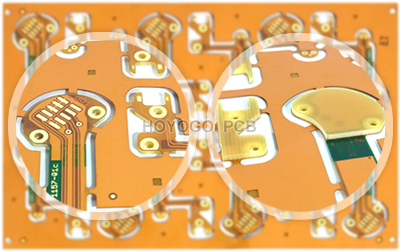

SHENZHEN HOYOGO ELECTRONIC TECHNOLOGY CO., LTD. is a international, professional, reliable flexible circuit board manufacturer. HoYoGo can also provide you with HDI PCB, gold finger PCB, hard gold PCB, flexible PCB, R-F PCB, metal base PCB, quick-turn PCB production service etc.

At present, FPC flexible circuit boards include 4 types: single-sided, double-sided, multilayer flexible circuit boards and rigid-flex circuit boards.
1. Single-sided flexible circuit boards are the lowest cost printed circuit boards that do not require high electrical performance. For single-sided wiring, a single-sided flexible circuit board should be used. It has a layer of chemically etched conductive patterns, and the conductive pattern layer on the surface of the flexible insulating substrate is a rolled copper foil. The insulating substrate can be polyimide, polyethylene terephthalate, aramid cellulose ester and polyvinyl chloride.
2. The double-sided flexible circuit board is a conductive pattern made by etching on both sides of the insulating base film. Metallized holes connect the patterns on both sides of the insulating material to form a conductive path, a series of flexible design and use functions. The cover film can protect single-sided and double-sided wires and indicate where the components are placed.
3. Multi-layer flexible circuit board is to laminate 3 or more layers of single-sided or double-sided FPC together, and form metallized holes by drilling and electroplating to form conductive paths between different layers. In this way, there is no need to use a complicated welding process. Multilayer circuits have huge functional differences in terms of higher reliability, better thermal conductivity and more convenient assembly performance. When designing the layout, the mutual influence of assembly size, number of layers and flexibility should be considered.
4. The traditional rigid-flex circuit board is composed of rigid and flexible substrates selectively laminated together. The structure is compact, and the conductive connection is formed with metalized holes. If a printed circuit board has components on the front and back sides, rigid-flex circuit boards are a good choice. But if all the components are on one side, it will be more economical to choose a double-sided flexible circuit board and laminate a layer of FR4 reinforced material on its back.
5. The FPC flexible circuit board with a hybrid structure is a multi-layer board, and the conductive layer is composed of different metals. An 8-layer board uses FR-4 as the inner layer medium and polyimide as the outer layer medium. Leads extend from three different directions of the main board, and each lead is made of a different metal. Constantan alloy, copper and gold are used as independent leads. This hybrid structure is mainly used for the relationship between electrical signal conversion and thermal conversion, and is the only feasible solution under the relatively harsh low temperature conditions of electrical performance. It can be evaluated by the convenience of the internal connection design and the total cost to achieve the best performance-price ratio.
